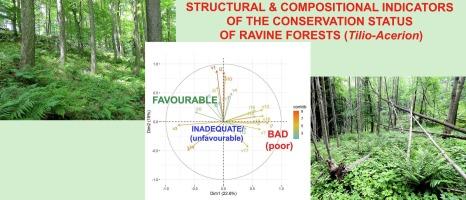森林生境保护状况的结构和组成指标:以欧盟优先生境类型Tilio-Acerion为例
IF 7
2区 环境科学与生态学
Q1 ENVIRONMENTAL SCIENCES
引用次数: 0
摘要
维持生境类型的保护状况,如本研究评估的峡谷森林(Tilio-Acerion),是欧洲自然2000网络的优先事项。峡谷森林通常出现在较小的破碎地区,但在整个欧洲森林中广泛分布。根据《栖息地指令》第17条,支持监测和报告《自然2000》栖息地保护状况的可靠指标往往是缺乏的。因此,我们测试了一组161个结构和组成变量,作为斯洛文尼亚东部一个Natura 2000遗址中接近自然管理的峡谷森林保护状况的潜在指标。研究的林分从以假高原槭为主的林分到以黄曲霉和椴为主的林分。大多数森林被分类为具有有利或不充分的养护状况。主要压力包括猎物的啃食和关键树种的死亡,主要是外来真菌入侵造成的。有利的保护状况与在岩石山脊和陡峭斜坡上较少集中管理的椴为主的林分有关。它还与较高的树层覆盖有关,特别是在保存完好的林分中,假扁桃槭。相反,保护状况较差的指标与受外来真菌侵袭严重的黄曲霉(Fraxinus excelsior)为主的林分有关,导致直立和躺卧枯木量增加。由此导致的树木死亡产生了更多的开阔林冠,增加了森林地面的光可用性,这表明草本和灌木层的植物物种数量较多。气候变化的不利影响,包括病虫害的爆发和其他干扰,可能日益威胁到峡谷森林的保护状况。为了确保谷地森林继续保持良好的养护状况,必须监测关键指标并采取适当的森林管理措施。本文章由计算机程序翻译,如有差异,请以英文原文为准。

Structural and compositional indicators of the conservation status of forest habitats: A case study of ravine forests – EU priority habitat type Tilio-Acerion
Maintaining the conservation status of habitat types such as the ravine forests (Tilio-Acerion) assessed in this study is a priority of the European Natura 2000 network. Ravine forests often occur in smaller, fragmented areas, but are widely distributed throughout European forests. Reliable indicators of the conservation status of Natura 2000 habitats, which support monitoring and reporting under Article 17 of the Habitats Directive, are often not available. Therefore, we tested a set of 161 structural and compositional variables as potential indicators of the conservation status of close-to-nature managed ravine forests in a Natura 2000 site in eastern Slovenia. The studied forests ranged from Acer pseudoplatanus-dominated stands to those dominated by Fraxinus excelsior or Tilia species. Most forests were classified as having either a favourable or inadequate conservation status. The main pressures included game browsing and mortality of the key tree species, primarily caused by invasive alien fungi. Favourable conservation status was associated with less intensively managed Tilia-dominated stands on rocky ridges and steep slopes. It was also linked to higher tree layer cover, particularly of Acer pseudoplatanus, in well-preserved forest stands. Conversely, indicators of bad conservation status were associated with Fraxinus excelsior-dominated stands that had been severely affected by invasive alien fungi, resulting in increased volumes of standing and lying deadwood. The resulting tree mortality created more open stand canopies with increased light availability at the forest floor, as indicated by the higher number of plant species in the herb and shrub layer. The conservation status of ravine forests is likely to be increasingly threatened by the adverse effects of climate change, including pests and disease outbreaks and other disturbances. To ensure the continued favourable conservation status of ravine forests, it is essential to monitor key indicators and apply appropriate forest management measures.
求助全文
通过发布文献求助,成功后即可免费获取论文全文。
去求助
来源期刊

Ecological Indicators
环境科学-环境科学
CiteScore
11.80
自引率
8.70%
发文量
1163
审稿时长
78 days
期刊介绍:
The ultimate aim of Ecological Indicators is to integrate the monitoring and assessment of ecological and environmental indicators with management practices. The journal provides a forum for the discussion of the applied scientific development and review of traditional indicator approaches as well as for theoretical, modelling and quantitative applications such as index development. Research into the following areas will be published.
• All aspects of ecological and environmental indicators and indices.
• New indicators, and new approaches and methods for indicator development, testing and use.
• Development and modelling of indices, e.g. application of indicator suites across multiple scales and resources.
• Analysis and research of resource, system- and scale-specific indicators.
• Methods for integration of social and other valuation metrics for the production of scientifically rigorous and politically-relevant assessments using indicator-based monitoring and assessment programs.
• How research indicators can be transformed into direct application for management purposes.
• Broader assessment objectives and methods, e.g. biodiversity, biological integrity, and sustainability, through the use of indicators.
• Resource-specific indicators such as landscape, agroecosystems, forests, wetlands, etc.
 求助内容:
求助内容: 应助结果提醒方式:
应助结果提醒方式:


